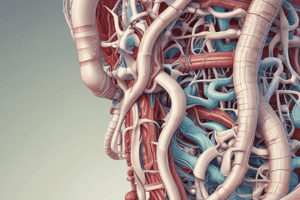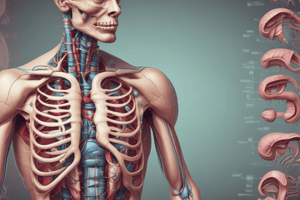Podcast
Questions and Answers
What extends as a single tube from the esophagus to the distal portion of the anal canal?
What extends as a single tube from the esophagus to the distal portion of the anal canal?
- The gastrointestinal tract (correct)
- The respiratory system
- The nervous system
- The circulatory system
What are the four main layers of the GI tract wall?
What are the four main layers of the GI tract wall?
- Mucosa, submucosa, muscularis propria, and nervous tissue
- Mucosa, submucosa, muscularis propria, and epithelium
- Mucosa, submucosa, muscularis propria, and either serosa or adventitia (correct)
- Mucosa, submucosa, muscularis propria, and lamina propria
What is the outermost layer of the mucosa in the esophagus?
What is the outermost layer of the mucosa in the esophagus?
- Lamina propria
- Muscularis mucosa (correct)
- Submucosa
- Epithelium
What type of cells are found in the epithelial layer of the esophagus?
What type of cells are found in the epithelial layer of the esophagus?
What is the function of the lamina propria in the esophagus?
What is the function of the lamina propria in the esophagus?
What is the purpose of the muscularis mucosa in the esophagus?
What is the purpose of the muscularis mucosa in the esophagus?
What is the reason for the circular or dot-like appearance of the muscle fibers in the image?
What is the reason for the circular or dot-like appearance of the muscle fibers in the image?
What is the lower esophageal sphincter (LES) considered to be?
What is the lower esophageal sphincter (LES) considered to be?
What is the result of prolonged exposure to gastric acid in the lower esophagus?
What is the result of prolonged exposure to gastric acid in the lower esophagus?
What is the condition called when the normal stratified squamous cells of the lower esophageal lining transform into a mucus-secreting epithelium?
What is the condition called when the normal stratified squamous cells of the lower esophageal lining transform into a mucus-secreting epithelium?
What is the increased risk associated with Barrett esophagus?
What is the increased risk associated with Barrett esophagus?
What is required for the diagnosis of Barrett esophagus?
What is required for the diagnosis of Barrett esophagus?
Flashcards are hidden until you start studying
Study Notes
Esophageal Structure and Function
- Muscle fibers in the esophagus appear circular or dot-like due to their longitudinal orientation.
- The lower esophageal sphincter (LES) is a physiological or functional sphincter, not an anatomical one, with no distinct thickening or muscle.
Gastric Acid Reflux and Barrett Esophagus
- Improper functioning of the LES can lead to gastric acid reflux into the lower esophagus, causing heartburn.
- Prolonged exposure to gastric acid can damage the esophageal epithelium, prompting the body to adapt by transforming stratified squamous cells into a mucus-secreting epithelium with simple columnar cells.
- This transformation is known as Barrett esophagus, a form of metaplasia, which increases the risk of developing esophageal adenocarcinoma.
- Barrett esophagus can be identified by "Salmon-colored" patches at the lower segment of the esophagus using an endoscope.
Gastrointestinal Tract Structure
- The gastrointestinal (GI) tract extends from the esophagus to the anal canal, maintaining 4 main layers: mucosa, submucosa, muscularis propria, and either an outer serosa or adventitia.
- The 4 layers vary in structure and function across different regions of the GI tract, with the mucosa undergoing the most significant changes.
Esophageal Mucosa
- The mucosa of the esophagus consists of 3 main layers: epithelium, lamina propria, and muscularis mucosa.
- The epithelial layer is thick and composed of stratified squamous non-keratinized cells.
- The lamina propria is a thin layer of dense irregular connective tissue that provides support to the epithelium.
- The muscularis mucosa is the outermost layer of the mucosa, composed of smooth muscle.
Studying That Suits You
Use AI to generate personalized quizzes and flashcards to suit your learning preferences.




